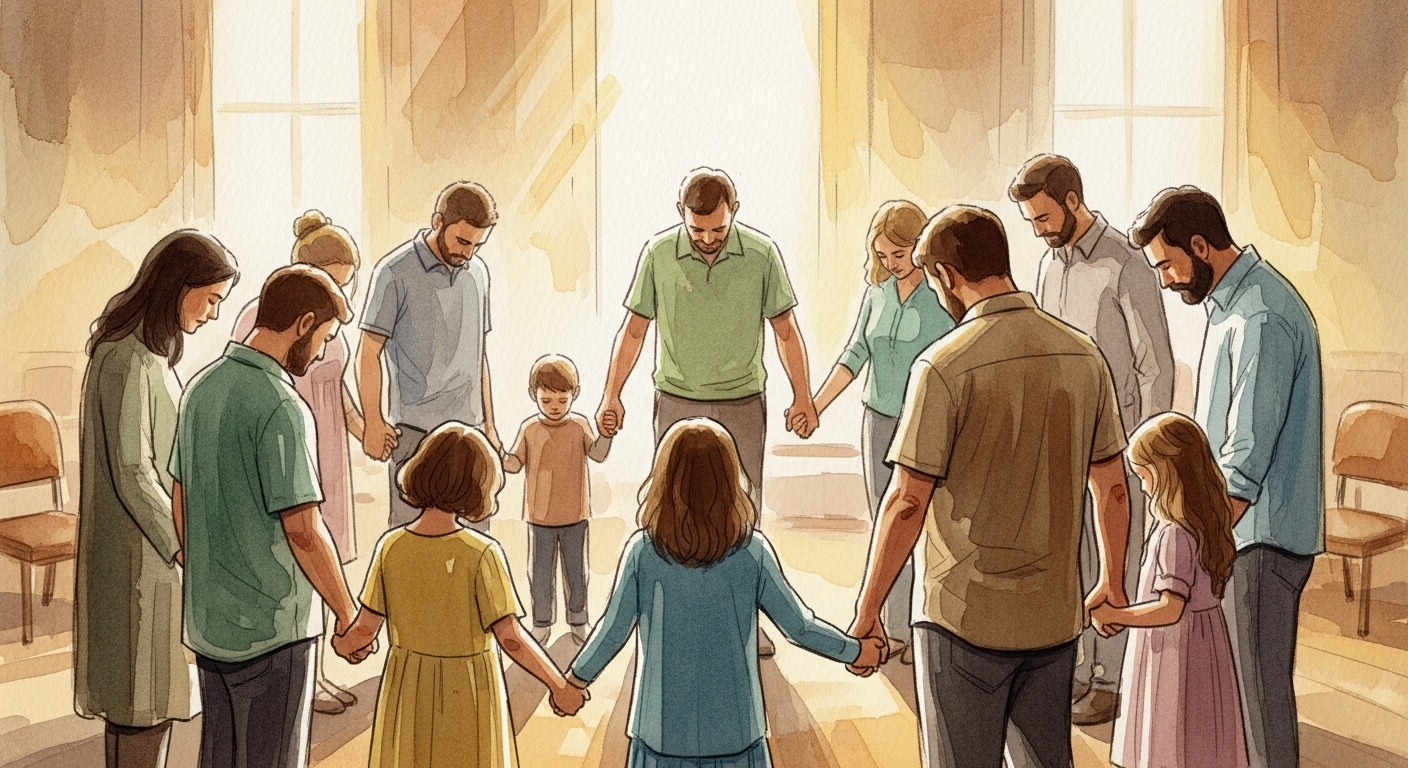Restoring Peace In The Church: Overcoming Division With Love
You’ve seen it before: a small disagreement grows into a gulf, whispers turn into factions, and the shared mission you once had together feels like a distant memory. Restoring peace in the church isn’t a soft, optional add-on to ministry — it’s central to your calling. When you lead people, you’re not only managing programs; you’re stewarding relationships, being responsible for the spiritual health of a body that is meant to reflect Christ. In a broken world, your church should be a place where unity in the church is prioritized, protected, and practiced.
This article walks you through biblical foundations, practical leadership steps, and spiritual disciplines you can apply to overcome division with love. You’ll find scriptural anchors and real-world strategies that respect both truth and grace so you can bring people back together without compromising the gospel.
Understanding Division in the Church
You can’t repair what you don’t diagnose. Division often looks obvious in its symptoms — cliques, gossip, cold shoulders — but less obvious in its roots. You’ll want to identify both the surface signs and the hidden dynamics so that your response addresses the real problem, not just the symptom.
Recognize the Signs of Division
You’ll notice strain when attendance drops among certain groups, when volunteers split into teams that barely talk, or when decision-making becomes politicized. Emotional signs include defensiveness, avoidance, and a sharp increase in “he said/she said.” Spiritual signs include a decline in prayer, worship, and generosity. A clear biblical admonition against such splintering is found in Paul’s plea: “I appeal to you, brothers and sisters, in the name of our Lord Jesus Christ, that all of you agree with one another” (1 Corinthians 1:10). You need to see these signs early so you can act with both speed and wisdom.
Root Causes of Division
Division rarely begins with a single, isolated argument. It grows from multiple sources: unchecked sin, pride, miscommunication, theological misunderstanding, cultural differences, or power struggles. Sometimes it’s in personality clashes; sometimes it’s in competing visions for ministry. You’ll often see a combination. Paul warned about divisive behavior and false teaching that pulls people away from truth (Romans 16:17). The wiser your diagnosis, the more effective your response will be.
Biblical Examples of Division and Reconciliation
The New Testament is candid about conflict. Look at Corinth — gifted, dynamic, fractured — and notice how Paul addresses both the symptoms and the theology behind the split (1 Corinthians 1:10). Then look at Acts 15, where the early church navigated a heated dispute about Gentile believers and Jewish law through collective listening and humility (Acts 15:6-11). These stories teach you to combine scripture, prayer, and communal decision-making when restoring unity in the church.
Theological Foundations for Unity
If you lead without a firm theological grounding, your fixes will be temporary. Unity in the church is not merely a social goal; it’s theological — rooted in the gospel and in Jesus’ prayer for his followers. You’ll need to teach this foundation clearly and consistently.
God’s Heart for Unity
Jesus prayed that his followers would be one, reflecting the unity of the Father and the Son so that the world might believe (John 17:20-23). You must help people see that unity is missional: it’s part of how God’s love is demonstrated to the world. When you emphasize unity in the church, you’re encouraging believers to live into the testimony Jesus intentionally chose.
Unity Is Not Uniformity
Unity doesn’t mean everyone looks or thinks the same. The apostle Paul stressed that the body of Christ has many parts with different roles, yet all are essential (1 Corinthians 12:12-27). Ephesians calls you to “make every effort to keep the unity of the Spirit through the bond of peace” while also recognizing diversity in gifts and callings (Ephesians 4:3-6). You’ll need to teach the difference between healthy diversity and harmful division.
Love as the Bond of Unity
Paul’s counsel to put on love as the supreme virtue is practical and powerful: “And over all these virtues put on love, which binds them all together in perfect unity” (Colossians 3:14). Love isn’t sentimental; it’s action-oriented, choosing the good of the other. If you want to restore unity in the church, you’ll encourage behaviors that demonstrate patience, forgiveness, and self-sacrificial service.

Practical Steps for Leaders to Restore Unity
You’re a steward of both people and processes. Restoring peace takes spiritual work and practical systems. Here’s how to lead well through conflict so unity in the church is restored and strengthened.
Prioritize Prayer and Humility
Begin where Jesus began — in dependence on the Father. Pray for wisdom, soften hearts, and ask God to reveal your own blind spots. Philippians urges you to adopt the mindset of Christ — humility that puts others before self (Philippians 2:1-4). Humbly modeled leadership invites others to lower their defenses and opens the way for reconciliation.
Create Safe Spaces for Honest Conversation
Conflict resolution requires honest conversation, but honesty must be carried out in a safe context. Use a gentle, structured approach based on Matthew 18: “If your brother or sister sins, go and point out their fault, just between the two of you” (Matthew 18:15). Teach and practice confidentiality, clear agendas, and agreed-upon goals. People return to safety faster when they see leaders hold to fair, transparent processes.
Model Confession and Forgiveness
Nothing heals like mutual confession and forgiveness. You should model the discipline of confessing your failures publicly when appropriate, and asking for and offering forgiveness readily. James encourages believers to confess sins to one another for healing (James 5:16). Likewise, Jesus’ call to forgive as you’ve been forgiven is non-negotiable (Matthew 6:14-15). When leaders confess, it disarms suspicion and models repentance as a virtue, not a stigma.
Use Restorative, Not Punitive, Measures First
Your first instinct should not be to punish, but to restore. Paul counseled the Corinthian church to deal with sin in a way that aims for repentance and restoration, not merely retribution (2 Corinthians 2:5-8). Discipline has a place, but your process should exhaust paths to reconciliation before moving to exclusion.
Teach Clear Theology and Allow Healthy Disagreement
You’ll avert many divisions by proactively teaching core doctrines and drawing lines where the gospel is at stake while allowing freedom in non-essentials. Romans 14 models how to live with differences of conviction without destroying the brother or sister for it (Romans 14:1-4). A church that teaches young leaders how to disagree well is less likely to fracture over secondary issues.
Establish Structures for Decision-Making
When the ground rules for decision-making are vague, conflicts get personal. Create clear governance patterns: who decides what, how input is gathered, and how appeals are handled. Acts 15 shows a healthy example: leaders gathered, listened to scripture and testimony, and made a communal decision with a letter that clarified the way forward (Acts 15:6-29). You’ll be wise to develop processes that people trust.
Communication Strategies That Heal
Words matter — how you say something often matters more than what you say. As a leader, you can shape tone, set expectations for speech, and teach people how to engage in conflict with dignity.
Listen More Than You Speak
James 1:19 gives you a simple but revolutionary rule: be quick to listen, slow to speak, slow to become angry (James 1:19). Listening disarms, builds empathy, and reveals the heart beneath the argument. When you lead meetings about conflict, make sure the rule of listening is enforced at the start.
Use Restorative Questions, Not Accusations
“How did that feel for you?” or “What do you need from me to move forward?” invite repair. Accusatory questions shut people down. Restorative questions focus on damage done and how to repair it. This approach mirrors Jesus’ patient, probing style — asking seekers about their needs and inviting them into responsibility.
Protect the Vulnerable and Correct Public Narratives
Gossip is a master of division. You must crush it by setting norms and correcting public narratives quickly. Encourage direct conversation and prohibit triangulation. When something sensitive has gone public, you should work to restore truth and dignity without violating confidentiality. Your transparency can reduce rumors and stop the spiral of suspicion that undermines unity in the church.
Rebuilding Trust Over Time
Trust isn’t rebuilt overnight. It’s a slow accumulation of small, faithful acts. You’ll need endurance, realistic timelines, and measurable steps that show progress.
Focus on Small Wins
Start with manageable actions that demonstrate change — a joint service project, a shared meal, or collaborative prayer gatherings. These small wins start to recalibrate relationships and rebuild social capital. Consistent, humble follow-through communicates credibility. As Paul models reconciliation at Corinth, incremental grace and correction moved the community toward restored fellowship (2 Corinthians 7:8-11).
Celebrate Shared Mission and Service
Remind people of why you’re together: to love, serve, and make disciples. Engage opposing groups in a ministry project where they must cooperate toward a shared goal. When people labor together for the kingdom, relational barriers often lower. Your mission acts as a centripetal force that draws people back to the center: Christ.
Invest in Discipleship and Spiritual Formation
Teach practices that change hearts: confession, fasting, accountability, Scripture memorization, and mentoring. Leaders should prioritize spiritual formation because technical fixes will not address the heart-level issues that produce division. Ephesians asks you to grow into maturity so that the church attains unity (Ephesians 4:13). When people are spiritually mature, their capacity for grace increases.
Preventing Future Division
You don’t only want to restore unity in the church; you want to prevent recurring fractures. Prevention requires culture, structure, and intentional formation.
Cultivate a Culture of Grace and Truth
Teach both grace and truth consistently. Over-emphasizing either one creates imbalance: grace without truth becomes permissiveness; truth without grace becomes harshness. John insists on walking in the light and confessing sin so fellowship remains healthy (1 John 1:7-9). As a leader, model and teach how to hold both.
Develop Leadership, Multiplication, and Diversity
Train leaders from different backgrounds to share authority and perspective. When decision-making is broad-based and representative, you reduce resentment and the perception of favoritism. Paul’s model of gifting and shared ministry shows the wisdom of distributed leadership (1 Corinthians 12:4-11). Invest in leadership development so that succession disputes don’t become sources of division.
Regularly Revisit Vision and Values
Vision-casting isn’t a one-time event. Reiterate why you exist together and how you pursue your mission. Keep values visible and tie decisions back to them. Regular teaching on unity in the church helps make it a recurring priority, not a slogan that’s forgotten when tensions rise.

When Reconciliation Isn’t Possible
There are hard realities: some relationships won’t be restored despite your best efforts. You’ll need wisdom to know when to persevere, when to set boundaries, and when to let go.
Boundaries and Loving Separation
If someone persistently undermines gospel unity, spreads malice, or refuses repeated calls to reconciliation, you must protect the flock. Romans 16:17 speaks to watching out for those who cause division and choosing to avoid them (Romans 16:17). This is painful, but sometimes necessary to prevent further damage. When separation occurs, do it with clarity, prayer, and a posture of continued love and willingness to restore if repentance happens.
Keep Loving and Praying for the Ones Who Leave
Even if a person leaves, you’re not free from love. Jesus’ impulse toward his enemies was prayer and intercession. Paul models continuance in love even after disciplinary actions — the goal remains restoration (2 Corinthians 2:5-11). Continue to pray for those who walk away and leave the door open for reconciliation where possible.
Relying on the Spirit
You can implement systems and train leaders, but only the Spirit truly changes hearts. Dependence on God should be primary in your strategy for restoring peace.
Look for the Fruit of the Spirit
When the Spirit is at work, you’ll see love, joy, peace, patience, kindness, goodness, faithfulness, gentleness, and self-control (Galatians 5:22-23). These are not merely ethical goals; they’re indicators that God is transforming people toward true unity in the church. Pray for these fruits and encourage practices that cultivate them.
Depend on God More Than Techniques
Techniques matter — structured conversations, trained mediators, policy changes — but they’re not ultimate. John’s vine metaphor reminds you that apart from Jesus you can do nothing; abiding in him is the source of lasting fruit and unity (John 15:4-5). Make spiritual disciplines central to any unity strategy.
Practical Scenarios and How to Respond
You lead different personalities and face different situations. Here are a few common scenarios and practical ways to respond that balance truth, grace, and leadership responsibility.
Scenario: A Rapidly Escalating Gossip Problem
Your response: Stop public commentary, convene key leaders, and initiate a week of focused prayer and teaching on speech. Invite those involved into direct conversations using Matthew 18 steps (Matthew 18:15-17). Emphasize confession and restore relationships publicly where damage was public.
Scenario: A Theological Dispute That Splits Volunteers
Your response: Host a series of teaching forums that address the theological issue with grace and clarity. Create small groups that study Scripture together and require agreement on mission and essential doctrine for those in leadership. Use Romans 14’s framework to distinguish convictions from essentials (Romans 14:1-5).
Scenario: Power Struggles Over Vision and Direction
Your response: Revisit governance structures, ensure representative decision-making, and create a structured timeline for strategic decisions. Use Acts 15 as a model: gather testimonies, test against Scripture, and issue a unified letter or statement that clarifies the way forward (Acts 15:6-29). Transparency reduces suspicion.
Final Considerations
You won’t restore unity in the church overnight, and you won’t do it by willpower alone. It’s a process that requires prayer, humility, wise systems, and consistent pastoral care. The gospel compels you to pursue reconciliation — not because it’s easy, but because it’s essential. Paul’s charge to live at peace as much as it depends on you is a sober reminder that your responsibility is to pursue peace even when others resist (Romans 12:18).
Keep returning to scripture, model confession and forgiveness, teach robust theology that balances truth and love, and build processes that make reconciliation possible. As you do this, you’ll see unity in the church become less of a fragile aspiration and more of a lived reality that honors God and blesses your community.
Explore More
For further reading and encouragement, check out these posts:
👉 7 Bible Verses About Faith in Hard Times
👉 Job’s Faith: What We Can Learn From His Trials
👉 How To Trust God When Everything Falls Apart
👉 Why God Allows Suffering – A Biblical Perspective
👉 Faith Over Fear: How To Stand Strong In Uncertain Seasons
👉 How To Encourage Someone Struggling With Their Faith
👉 5 Prayers for Strength When You’re Feeling Weak

📘 Jesus and the Woman Caught in Adultery – Grace and Mercy Over Judgement
A powerful retelling of John 8:1-11. This book brings to life the depth of forgiveness, mercy, and God’s unwavering love.
👉 Check it now on Amazon 🛒💥
🔥 “Every great message deserves a home online.” 🌍💬🏡
Don’t let your calling stay hidden. Start a Christian blog or website using Hostinger — with 99.9% uptime, a free domain, and SSL, your voice can shine for God’s glory anytime, anywhere.
💥 Begin today. 🛒 Try it RISK-FREE! ✅
✝️ “Your body is God’s temple — care for it with purpose.” 💪💖🏛️
Renew your energy and restore balance naturally. Mitolyn helps support a healthy metabolism, giving you the vitality to live out God’s calling with strength and confidence.
🔥 Unlock Your Metabolic Power! ⚡Burn More Calories & Feel Great With Mitolyn. 💪
👉 Start Today. 🚀 Check Price Now. 🛒💰
💰 As a ClickBank & Amazon Affiliate, I earn from qualifying purchases.
📖 Acknowledgment: All Bible verses referenced in this article were accessed via Bible Gateway (or Bible Hub).
🚀 Want to explore more? 👉 Dive into our new post on Why Jesus? and experience the 🔥 life-changing truth of the Gospel!





